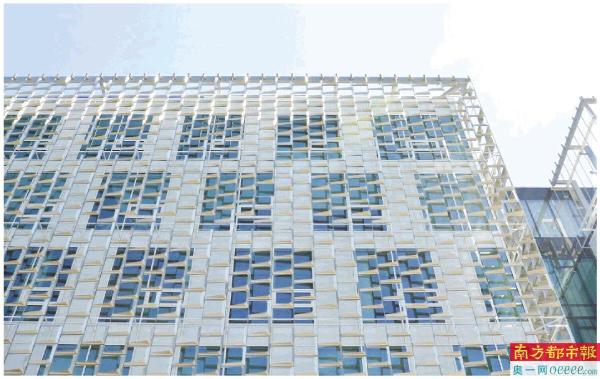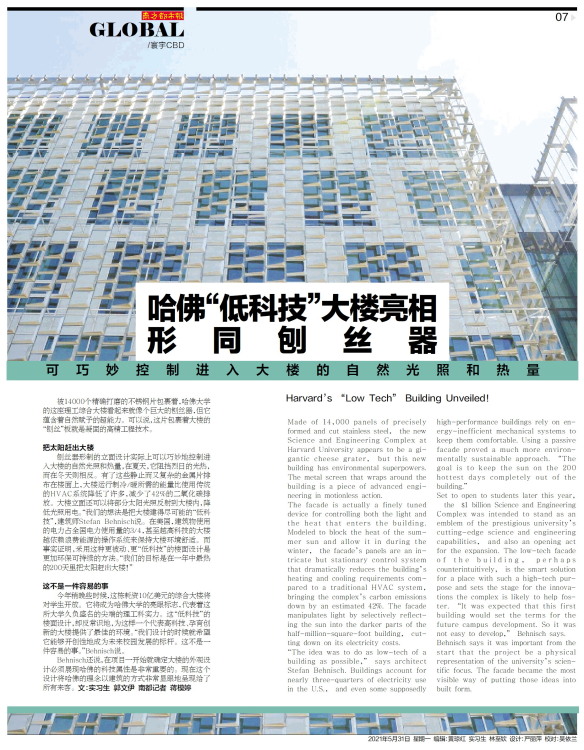
被14000个精确打磨的不锈钢片包裹着,哈佛大学的这座理工综合大楼看起来就像个巨大的刨丝器,但它蕴含着自然赋予的超能力。可以说,这片包裹着大楼的“刨丝”板就是凝固的高精工程技术。
把太阳赶出大楼
刨丝器形制的立面设计实际上可以巧妙地控制进入大楼的自然光照和热量,在夏天,它阻挡烈日的光热,而在冬天则相反。有了这些静止而又复杂的金属片排布在楼面上,大楼运行制冷/暖所需的能量比使用传统的HVAC系统降低了许多,减少了42%的二氧化碳排放。大楼立面还可以将部分太阳光照反射到大楼内,降低光照用电。“我们的想法是把大楼建得尽可能的“低科技”,建筑师Stefan Behnisch说。在美国,建筑物使用的电力占全国电力使用量的3/4,甚至越高科技的大楼越依赖浪费能源的操作系统来保持大楼环境舒适。而事实证明,采用这种更被动、更“低科技”的楼面设计是更加环保可持续的方法。“我们的目标是在一年中最热的200天里把太阳赶出大楼!”
这不是一件容易的事
今年稍晚些时候,这栋耗资10亿美元的综合大楼将对学生开放。它将成为哈佛大学的亮眼标志,代表着这所大学久负盛名的尖端的理工科实力。这“低科技”的楼面设计,却反常识地,为这样一个代表高科技、孕育创新的大楼提供了最佳的环境。“我们设计的时候就希望它能够开创性地成为未来校园发展的标杆。这不是一件容易的事。”Behnisch说。
Behnisch还说,在项目一开始就确定大楼的外观设计必须展现哈佛的科技属性是非常重要的。现在这个设计将哈佛的理念以建筑的方式非常显眼地呈现给了所有来客。文:实习生 郭文伊 南都记者 蒋模婷
Harvard’s “Low Tech” Building Unveiled!
Made of 14,000 panels of precisely formed and cut stainless steel, the new Science and Engineering Complex at Harvard University appears to be a gigantic cheese grater, but this new building has environmental superpowers. The metal screen that wraps around the building is a piece of advanced engineering in motionless action.
The facade is actually a finely tuned device for controlling both the light and the heat that enters the building. Modeled to block the heat of the summer sun and allow it in during the winter, the facade’s panels are an intricate but stationary control system that dramatically reduces the building’s heating and cooling requirements compared to a traditional HVAC system, bringing the complex’s carbon emissions down by an estimated 42%. The facade manipulates light by selectively reflecting the sun into the darker parts of the half-million-square-foot building, cutting down on its electricity costs.
“The idea was to do as low-tech of a building as possible,” says architect Stefan Behnisch. Buildings account for nearly three-quarters of electricity use in the U.S., and even some supposedly high-performance buildings rely on energy-inefficient mechanical systems to keep them comfortable. Using a passive facade proved a much more environmentally sustainable approach. “The goal is to keep the sun on the 200 hottest days completely out of the building.”
Set to open to students later this year, the $1 billion Science and Engineering Complex was intended to stand as an emblem of the prestigious university’s cutting-edge science and engineering capabilities, and also an opening act for the expansion. The low-tech facade of the building, perhaps counterintuitively, is the smart solution for a place with such a high-tech purpose and sets the stage for the innovations the complex is likely to help foster. “It was expected that this first building would set the terms for the future campus development. So it was not easy to develop,” Behnisch says.
Behnisch says it was important from the start that the project be a physical representation of the university’s scientific focus. The facade became the most visible way of putting those ideas into built form.

